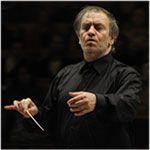
From 30 March to 13 April Valery Gergiev will be conducting eleven concerts with the London Symphony Orchestra. The concert programmes focus on symphony music by Alexander Scriabin and Olivier Messiaen.
The combination of these two names in one concert series is no chance circumstance: in their creative endeavours they had much in common – first and foremost the search for links between sound, colour and light. In all of Scriabin’s late works one can trace a search for light in music. In the score of Prométhée, ou le Poème du feu he traces out the role of light. The sounds of the three-tone harmony of Prometheus, correlating with the high overtones (“I needed light in music, I needed a radiant harmony that reflected the idea of light”), led to the presence in Scriabin’s music of a sensation of something mysterious, inconceivable and universally boundless.
Messiaen’s search for colour in music began in the 1920s and 30s and, in the 60s and 70s, resulted in a logical system that ended with his posthumously-published seventh volume Traité de rythme, de couleur et d’ornithologie containing tables of all of the composer’s sound and colour analogies. Messiaen referred to music connected with colour and light as “the highest caste of music” and spoke of the religious Christian sources of his programme of light and music at a performance at Notre Dame de Paris in 1977: “One can convey the breakthrough to the unseen and the inexpressible by using colour music and lead the listener to a sense of dazzling enchantment.” To achieve this effect, Messiaen enriched his musical language, striving to make it as vivid as possible, sparkling, moving back the borders of music by means of the exotic timbres of the ondes Martenot, the gamelan and the polyphony of birdsong etc.
According to the composer, “colour music is a kind of rainbow of sounds and colours that comes from Christ and spreads its reflection – this is the light of which St John speaks (‘The light shines in the darkness, and the darkness has not overcome it’) and Thomas Aquinas (‘God dazzles us by an excess of truth’). And in the Book of Revelation: ‘There before me was a throne in Heaven with someone sitting on it; and the one who sat there had the appearance of jasper and ruby. A rainbow that shone like an emerald encircled the throne.” Messiaen dedicated his opus Couleurs de la cité céleste to the precious stones of Heavenly Jerusalem in a series of chords with a very specific light recorded in the score. In Messiaen’s symphony Turangalîla we are presented with a “glittering” piano timbre interpretation, just as in Scriabin’s Prométhée; in the score of the opera Saint François d’Assise we have a role allocated to light and colour.
The series of concerts has been named Music in Colour. The concerts will feature all three of Scriabin’s symphonies as well as his symphonic poem Prométhée, ou le Poème du feu and Le Poème de l’extase and two early works by Messiaen – Les Offrandes oubliées (1930) and L’Ascension (1933), Frédéric Chopin’s Piano Concerto No 2 (soloist: Daniil Trifonov) and Franz Liszt’s Piano Concerto No 2 (Denis Matsuev); Matsuev will also be performing the solo in Scriabin’s Prométhée. The performance of Scriabin’s First Symphony will feature the London Symphony Chorus and Mariinsky Theatre soloists Yekaterina Sergeyeva (mezzo-soprano) and Alexander Timchenko (tenor).
The concerts will take place in London (30 March and 10 and 13 April), Brussels (1 April), Frankfurt (2 April), Dortmund (3 April), Freiburg (4 April), Paris (5 and 6 April), Milan (7 April) and Turin (8 April).
For details please go to the website of the London Symphony Orchestra.